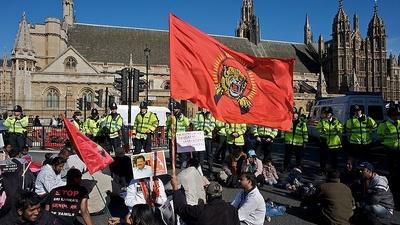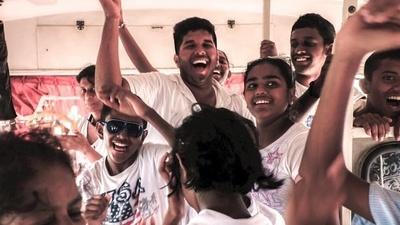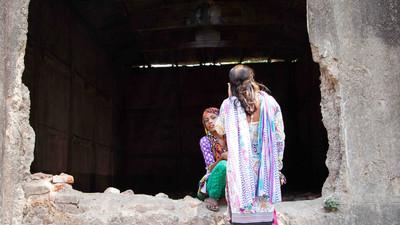Sri Lanka Massacred Tens of Thousands of Tamils While the World Looked Away
To the Tamils of northeast Sri Lanka and to much of their global diaspora, Isaipriya was a star: a presenter and actress who came to symbolize the Tamil resistance.
She was beautiful, and she read the news on Tiger television and performed in romantic Tamil musicals, singing the praises of Tamil Tiger war heroes and the Black Tiger suicide bombers who raced their explosive-packed speedboats into the vulnerable sides of Sri Lankan Navy ships.
Isaipriya was respected and admired, not just by the people of the Vanni—the small region in north Sri Lanka where the secessionist forces of the Liberation Tigers of Tamil Eelam (LTTE) had created a de facto state—but also by Tamils around the world, driven from their homeland by decades of discrimination, which occasionally exploded into outright pogroms among the Sinhalese majority in Sri Lanka.
"She was a lovely woman," said Benjamin Dix, who for four years was a UN staffer in Kilinochchi, the administrative capital of the Tiger state. Dix knew Isaipriya, and he understood the moral ambiguity of her message. "She was incredibly gentle and respectful," he said, "but at the same time, she stood for and symbolized the movement of the Tigers, which was hard and brutal and completely focused on their objective of gaining Tamil Eelam and an independent state within Sri Lanka."
In October 2008, the UN ordered Dix and the other few remaining international staffers out of the region after the Sri Lankan government, led by President Mahinda Rajapaksa, declared it could no longer guarantee their safety.
In reality, Rajapaksa wasn't concerned one bit about the safety of the UN staffers. He was about to launch the final offensive against the Tigers, and he didn't want any international observers.

A Sri Lankan government soldier ties Isaipriya's hands behind her back. Later that day, she would be sexually abused and executed. The photos in this article were taken by survivors as evidence—and by perpetrators as war trophies. They were supplied to the author by a variety of anonymous sources.
With the UN expelled and international journalists banned, the Sri Lankan government hoped and believed that what would happen over the next 138 days, as they made a push into Tiger-held territory, would remain a secret—a war without witnesses. But there were witnesses, survivors and perpetrators alike, and they had cameras and cell phones.
This war would be filmed in terrible detail—and for the past few years, with the help of exiled Sri Lankan journalists, diaspora Tamils, and survivors of the war, my colleagues at the UK's Channel 4 News and I have been compiling, analyzing, and authenticating this evidence. What began as a series of reports has evolved through two TV documentaries into a full-length feature documentary, No Fire Zone: The Killing Fields of Sri Lanka.
On May 19, 2009, the day after the official end of the war, the Sri Lankan Ministry of Defense posted on its website its regular war report, recording the deaths of senior Tamil Tiger officers. Isaipriya was listed as a casualty of war. The spelling had changed—and she'd been given the military rank of lieutenant colonel—but the message was clear: Isaipriya had died in action. A fighter.
The problem is that—like so much claimed by the Sri Lankan government, then and since—it was a lie.
I received proof of that lie four years later, in the form of a grainy video showing the capture of Isaipriya by Sri Lankan government soldiers. In the 48-second-long tape, Isaipriya is still alive. She is uninjured, but partially naked, distressed, disorientated, and being half-dragged, half-helped, from the shallow waters of a lagoon. Since then more photographs have emerged showing her and a 19-year-old woman named Ushalini Gunalingam, who had been captured with her. They are in custody, their arms tied behind their backs.
And then there is a final terrible video, shot by a Sri Lankan soldier on his cell phone as a grotesque war trophy. Isaipriya and Gunalingam have been stripped naked—apparently raped—and then executed. They lie in a pool of blood. "I would like to fuck it again," says an off-camera Sinhalese voice.

Vans and tractors driven for miles to the promised safety of the government's no-fire zones lie burnt or abandoned.
Sri Lanka gained independence from Britain in 1948, but colonial strategies of divide and rule had left a cancerous legacy. When the British left, power fell to the island's Sinhalese majority. The minority Tamils confronted institutional discrimination with nonviolent resistance, and the state responded by ramping up the attacks on them. Employment discrimination increased, restrictions were imposed on their access to further education, and new laws made Sinhala—which few Tamils spoke—the official language. Violent anti-Tamil attacks followed, the worst of which, in May 1958, cost more than 200 Tamil lives. A series of armed Tamil nationalist groups emerged.
On July 23, 1983, an ambush by a small guerrilla group known as the LTTE resulted in the death of 13 Sri Lankan soldiers. Pro-government supporters exploited the event to trigger the worst anti-Tamil riots in the country's history, a period now known as Black July. As many as 3,000 Tamil civilians were massacred in just one week, and tens of thousands fled to the traditional Tamil heartlands in the northeast.
Many young Tamils joined the insurrection, dedicating their lives to the fight for an independent Tamil state, Tamil Eelam. Control of that insurrection was swiftly seized by the LTTE, which, under its enigmatic young commander, Velupillai Prabhakaran, ruthlessly eliminated or subsumed its many rivals for Tamil loyalty. The war had begun.
For more on Sri Lanka, watch VICE News' doc 'Sri Lanka: Caught in the Crossfire':
The Tigers were brutal but effective. Over the next quarter-century, Prabhakaran built an army prepared to use conscripted child soldiers and suicide bombers against civilian targets, as well as traditional methods of guerrilla warfare. His movement, full of contradictions, confronted caste restrictions and encouraged women to fight as equals, yet allowed no political freedom, eliminated rivals, and demanded absolute loyalty—down to the cyanide capsules worn by each fighter to be swallowed in the event of capture. By 2008, the LTTE had constructed a functioning state in the north of the country, with its own banks, police, civil service, and armed forces. It even had its own TV station—with Isaipriya as its star. But things were about to change.
In 2008 Rajapaksa prepared to launch a brutal final offensive against the Tigers. On January 2, 2009, the Tamil capital, Kilinochchi, fell when the Tigers effectively abandoned the town and withdrew to the northeast.
By the middle of January 2009, with the Tigers in hopeless retreat, the Rajapaksa government declared the first of a series of what they called no-fire zones, into which they encouraged as many as 400,000 Tamil civilians to gather "for their own safety." But instead of protecting these no-fire zones, government forces relentlessly shelled them, all the while insisting, implausibly, they had a policy of "zero civilian casualties."

In a makeshift hospital on the grounds of an abandoned school, relatives care for their loved ones while the government denies them antibiotics and painkillers.
Innocent Tamil civilians died by the thousands, in what some regard as nothing less than a genocide. Episodes from that massacre were preserved like scenes from a nightmare in short video sequences, uploaded at necessarily low resolution on satellite phones during brief breaks in the shelling.
In one of the videos, two young girls, held back in their bunker in case another shell falls, scream in fear and anguish while in front of them the dead and terribly injured lie prostrate. Then one of the girls recognizes one of the damaged bodies in front of her. "Mama!" she screams.
Another family lies huddled in a shallow bunker. Shells are falling nearby. "Don't take the video," one woman, clasping her child protectively, screams at the cameraman. "Please get in the bunker. What are you going to do with the video? They are killing everyone." The cameraman keeps filming.
In the makeshift hospitals at the time, a series of medical points set up in abandoned primary schools, the suffering was truly awful. Critical shortages of antibiotics and anesthetics caused untold pain and countless unnecessary deaths.
Vany Viji, a young Tamil woman from London who had been visiting the region and became trapped by the fighting, was one of those who volunteered to help in the last hospital. Still traumatized by her memories of those days, she recalls helping to restrain a seven-year-old boy while, without general anesthetic, a doctor sawed off his left arm and leg, shattered irretrievably by a shell. "I was holding his mouth so he didn't scream."
A UN report concluded that the government deliberately and illegally denied humanitarian supplies like anesthetics. At the same time, government forces targeted and shelled these hospitals, killing hundreds.
But the Tigers were also complicit in the suffering. Reports spoke of Tigers opening fire on Tamil civilians who tried to escape the killing fields and test their luck with the government forces. The violent conscription of teenagers and children to work as laborers and fighters—publicly abandoned during the peace process—recommenced. Five years later, there is still no accurate figure for the dead.

The injured, the dying, and the dead spill out of the limited space in makeshift hospitals.
By May 17, 2009, the final no-fire zone had been overrun. It was smaller than Central Park in New York, but crammed with tens of thousands of civilians. Triumphant Sri Lankan soldiers, battle-weary and brutalized but fired up by the chauvinistic rhetoric of their commanders and political leaders, went on a grotesque rape and murder spree.
We know this because these soldiers—in an unconscious illustration of the culture of impunity in which they operated—recorded these terrible crimes on their mobile phones and camcorders. And over the past four years, more and more of this footage has emerged.
The first clip, uncovered by a group called Journalists for Democracy in Sri Lanka (JDS, a network of exiled Sri Lankan journalists from all communities), came to us at Channel 4 News. It showed bound, naked, and blindfolded prisoners being pushed to the ground and then executed, in cold blood, by shots to the head.
We then obtained footage showing the aftermath of another execution, in which one of the dead was identified as Balachandran Prabhakaran, the 12-year old son of the Tiger leader, Velupillai Prabhakaran.
The boy is lying on the ground surrounded by five executed men, believed to be his bodyguards. But it is the pattern of bullet wounds on the boy that is most disturbing. He has been shot five times. The first entry wound, on the left of his chest, is surrounded by speckling or "propellant tattooing"—evidence that this gun was just a couple of feet away from his chest when the bullet was fired. The other wounds—entering at a shallower angle—suggest they were fired after he had fallen back as a result of the first, probably fatal, shot.

Balachandran Prabhakaran, the 12-year-old son of the Tamil Tiger leader, held captive in a Sri Lankan government bunker. A few hours later he would be shot and killed.
The government denied that their forces had executed this child—just as they denied having killed Isaipriya.
But then, via JDS, we obtained two more photographs.
These show Balachandran alive, in a government bunker, apparently in the custody of a uniformed Sri Lankan army officer. He is eating a snack, and looks up anxiously, like a lost child in a supermarket. Metadata encoded in the stills suggest these pictures were taken just two hours before the ones showing him dead. It seems this boy was held in custody, and even offered a snack, before he was taken and executed.
Six years after these terrible events, not a single person has been charged, and neither Rajapaksa nor his brother, the defense secretary Gotabaya Rajapaksa (a US citizen), has faced any consequences. One UN report concluded that as many as 40,000 Tamils may have died, mostly as a result of government shelling. A subsequent UN report suggested the true figure could even reach 70,000.
This January, the growing corruption and nepotism of the Rajapaksa government finally proved too much for many Sinhalese people to bear, and with the help of tactical voting by the Tamils, the Sri Lankan people removed them from power. But while the new government has made promises to mount a domestic inquiry into the crimes, they have also promoted or reinstated military officers accused of direct or command responsibility for those crimes.
For the traumatized Tamils, such a domestic process would be the final insult—nothing less than victor's justice over a beaten people. Meanwhile, a report ordered by the UN Human Rights Council has been delayed until September, and some fear that the call for an international judicial reckoning is weakening. Although the evidence is now here for all the world to see, the search for justice is far from over.
Callum Macrae is the director of the film No Fire Zone. Reporting for this article was generously funded by the Pulitzer Center on Crisis Reporting.
http://www.vice.com/read/death-of-a-tiger-0000710-v22n8





No comments:
Post a Comment